One of the greatest museums in the Netherlands is located in the second-most populous city in the country, Rotterdam.
Museum Boijmans Van Beuningen was closed in 2019 but the Depot, an area that allows you to peek backstage where the paintings are held, was opened in 2021.
It was established in 1849 from the collection of Dutch art collector Frans Jacob Otto Boijmans (1767-1847).
The collection of businessman Daniël George van Beuningen (1877–1955) was added in 1958 and the museum was renamed in honor of both men.
Today, the museum located at the Museumpark in Central Rotterdam holds a collection of over 151,000 artworks, including an incredible collection of paintings.
In this article, you’ll discover some of the most famous paintings at Museum Boijmans Van Beuningen. Please note, these are currently held at a building in Rotterdam called the “Depot Museum Boijmans Van Beuningen.”
1. The Three Marys at the Tomb – Jan / Hubert van Eyck (?)
- Date created: 1410-1425
- Dimensions: 71.5 x 90 centimeters (28.1 x 35.4 inches)
The Three Marys at the Tomb is a painting that was completed in the first half of the 15th century. Unfortunately, we don’t really know for sure who completed it. It has been attributed to either Jan van Eyck (1390-1441), one of the greatest Early Netherlandish artists in history, or his brother Hubert van Eyck (1385-1426).
It’s also possible that both artists worked on this painting together, similar to the monumental Ghent Altarpiece. Either way, the level of detail certainly makes it likely that Jan had a hand in it. It depicts a scene from the New Testament related to the Three Marys, The Virgin Mary, Mary Magdalene, and Mary Salome.

2. The Glorification of the Virgin – Geertgen tot Sint Jans
- Date created: 1490
- Dimensions: 24.5 x 20.5 centimeters (9.6 x 8 inches)
The Glorification of the Virgin is a painting by Geertgen tot Sint Jans (1465-1495), another Early Netherlandish painter who lived and worked in Haarlem. He’s somewhat of a mysterious figure because nothing about his life is known and he only appeared in written documents in the year 1604.
The quality of his work was second to none and many religious works have been attributed to him. This work depicts the Virgin Mary who is surrounded by angels and musical instruments while she crushes the dragon beneath her. The inspiration for the painting came from a verse in the Book of Revelations which states:
And there appeared a great wonder in heaven, a woman clothed with the sun, and the moon under her feet, and upon her head a crown of twelve stars.
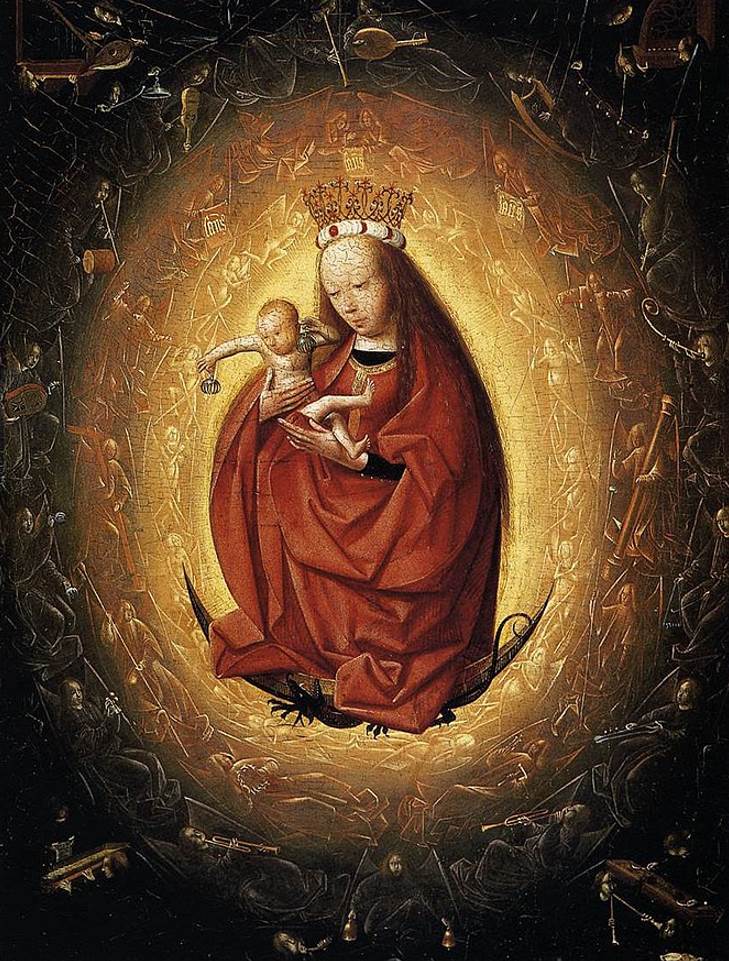
3. The Wayfarer – Hieronymus Bosch
- Date created: 1500
- Dimensions: 71 × 70.6 centimeters (28 × 27.8 inches)
The Wayfarer is the title of a painting by Hieronymus Bosch (1450-1516), a man who is world-famous for his fantastical works of art depicting Heaven and Hell. This work is likely a fragment of a much larger triptych or diptych which also featured other works such as “Allegory of Gluttony and Lust” and the “Ship of Fools and Death and the Miser.”
The painting is believed to represent a virtuous man who chooses to enter the gate on the right instead of visiting the house full of sin on the left. Bosch included the same figure on the exterior of the “Haywain Triptych” (1516) at the Prado Museum, a work he completed shortly before he passed away.
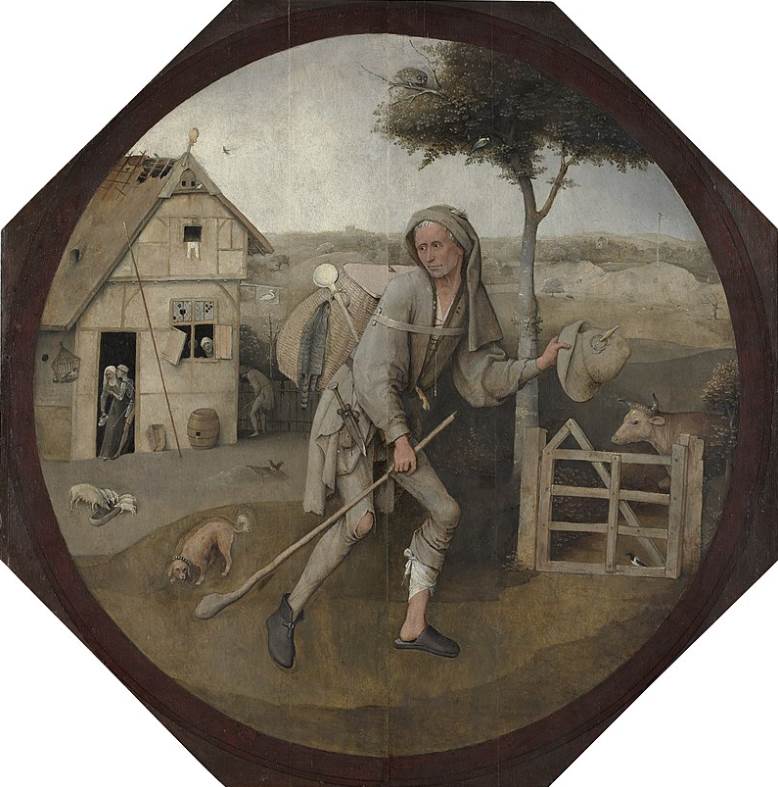
4. The Tower of Babel – Pieter Bruegel the Elder
- Date created: 1568
- Dimensions: 59.9 x 74.6 centimeters (23.5 x 29.3 inches)
The Tower of Babel is the title of three different paintings by Pieter Bruegel the Elder (1525-1569). The first was a very small version painted on ivory during a time when the artist was on holiday in Rome. This has been lost so only the much larger oil paintings remain today.
The large version is part of the collection of the Kunsthistorisches Museum in Vienna. The smaller version, also referred to as the “Little Tower of Babel,” is part of the collection of Museum Boijmans Van Beuningen in Rotterdam. Both works are similar and depict the construction of the Tower of Babel as described in the Book of Genesis.
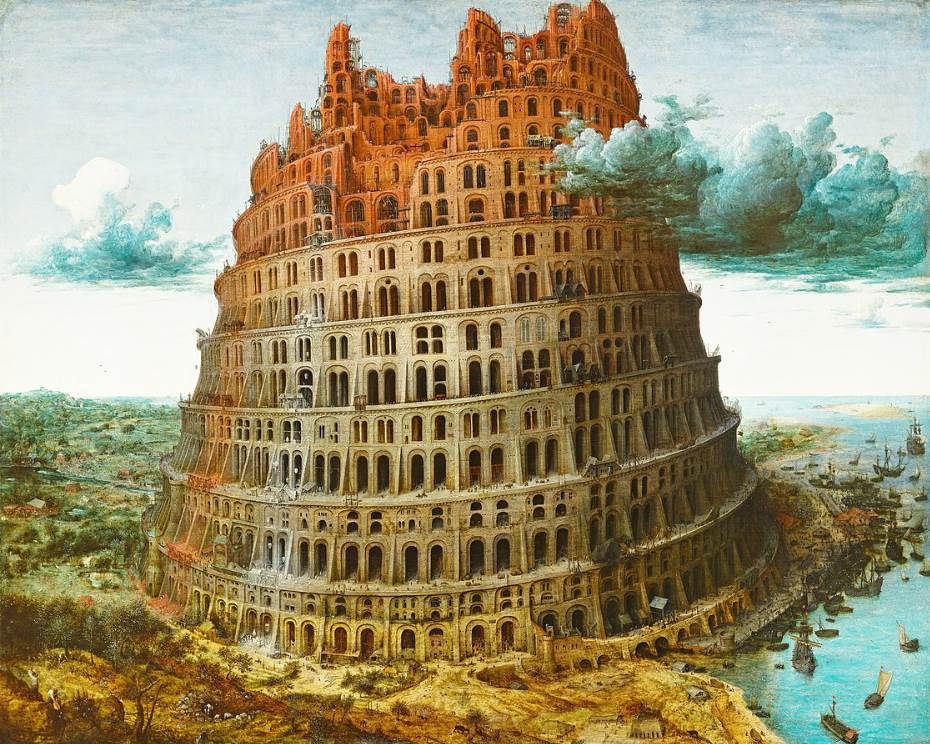
5. Titus at his Desk – Rembrandt van Rijn
- Date created: 1655
- Dimensions: 77 x 63 centimeters (30.3 x 24.8 inches)
Titus at his Desk is a work also known as “Titus at a Lectern” and is a painting by Rembrandt van Rijn (1606-1669), arguably one of the greatest Dutch artists in history. The title of the painting refers to the artist’s son Titus van Rijn (1641-1668) who was about 14 years old at the time.
Titus was often used as the model in Rembrandt’s oeuvre. He was the only surviving child of the artist and his first wife Saskia van Uylenburgh (1612-1642). Three other children of the couple died shortly after they were born. In this work, Rembrandt depicted the contemplative boy when he was writing.
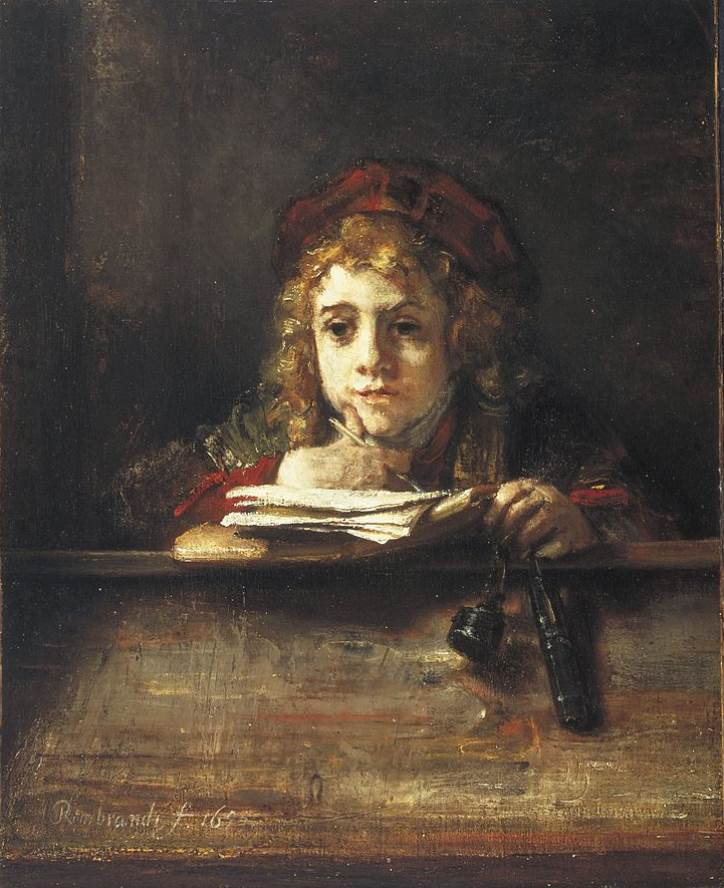
6. A Cornfield with the Zuiderzee in the background – Jacob van Ruisdael
- Date created: 1660
- Dimensions: 61 x 71 centimeters (24 x 27.9 inches)
A Cornfield with the Zuiderzee in the Background is the title of a painting by Jacob van Ruisdael (1629-1682), a Dutch artist who can be defined as the most notable landscape painter of the Dutch Golden Age. As the title suggests, it depicts the typical Dutch landscape on a relatively cloudy day.
The painting likely depicts the region around Naarden, a small city just east of Amsterdam. The Zuiderzee can be seen in the distance, a shallow bay of the North Sea that has been separated from it by the “Afsluitdijk.” Because of this construction, about 1,500 square kilometers (580 square miles) of land was reclaimed.
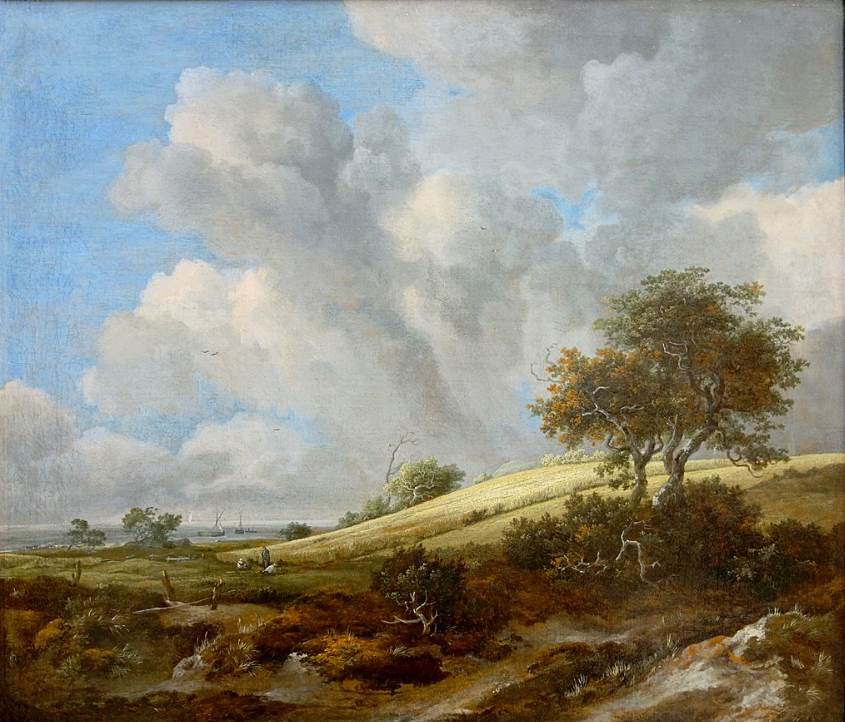
7. Poplars near Nuenen – Vincent van Gogh
- Date created: 1885
- Dimensions: 78 x 98 centimeters (30.7 x 38.5 inches)
Poplars near Nuenen is a painting by Vincent van Gogh, the famous Post-Impressionist artist who was living in his home country of the Netherlands at the time. It’s a remarkable work in his oeuvre which he referred to as “Symphony in Yellow.” He would produce an abundance of yellow paintings later on in his career.
This painting is considered to be a transitional work between the dark and gloomy paintings of his early years to the vivid and vibrant paintings of his time in France. Because of this, he likely reworked it later on. It was the first painting by the Dutch master to enter a public collection in 1903.

8. The Rider (Lyrical) – Wassily Kandinsky
- Date created: 1911
- Dimensions: 94 x 130 centimeters (37 x 51.1 inches)
The Rider or “Lyrical” is the title of a painting by Wassily Kandinsky (1866-1944), a Russian artist who moved to Munich in the late 19th century to pursue a career as a painter. It was a good choice because he became one of the most influential artists of the early 20th century when he transitioned from Impressionism to abstract art.
This painting was completed nearly a decade after he produced “The Blue Rider” (1903) a work that laid the foundation of the art group he co-founded with Franz Marc (1880-1916) called “Der Blaue Reiter.” He used a minimal amount of elements to depict this galloping horse with a rider on top.

9. Not to be Reproduced – René Magritte
- Date created: 1937
- Dimensions: 81.3 × 65 centimeters (32 × 26 inches)
Not to Be Reproduced is the title of a painting by René Magritte (1898-1967), a Belgian artist who tried to defy logic with his peculiar paintings. The Surrealist painter often placed common objects in unusual positions to challenge the viewer.
The painting was commissioned by an English poet named Edward James (1907-1984), a man who supported the Surrealist art movement, including Magritte. Although the face of the man can’t be seen, it’s considered to be a portrait of James. As in most of his works, the reflection in the mirror doesn’t make sense.
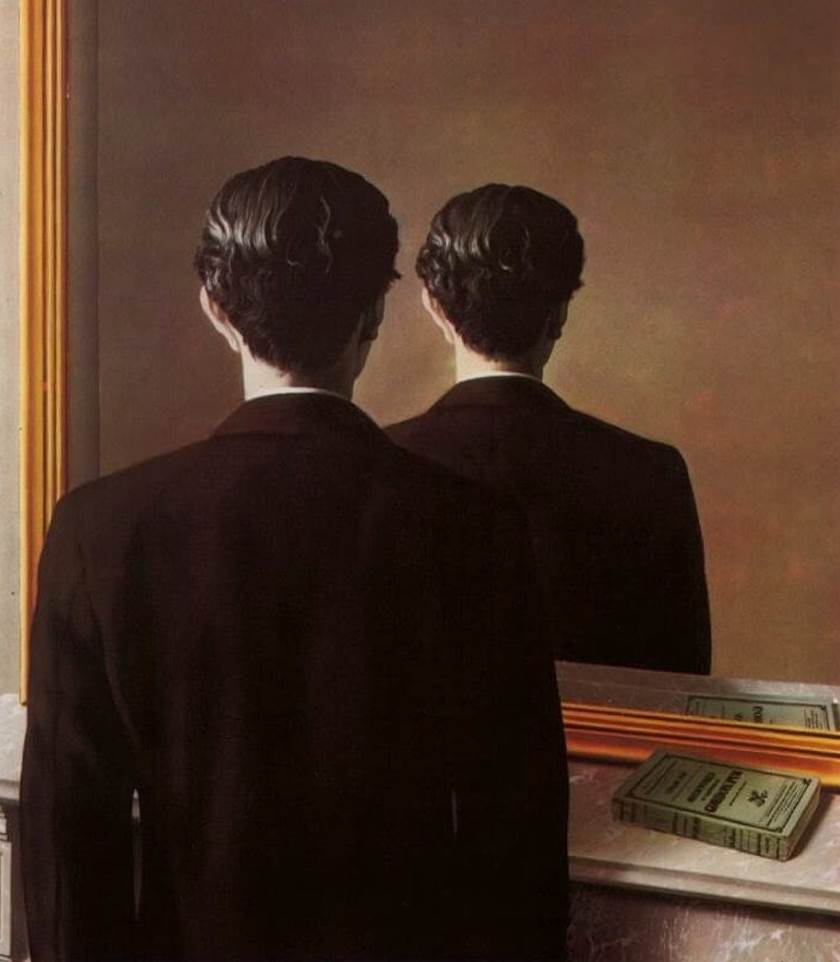
10. The Face of War – Salvador Dalí
- Date created: 1940
- Dimensions: 64 × 79 centimeters (25.2 × 31.1 inches)
The Face of War is one of the scariest paintings by Salvador Dalí (1904-1989), and that’s quite an achievement. Known for his peculiar works of art, the Spanish artist was inspired to paint this work when he was living in California after fleeing Europe at the start of World War II.
The Spanish Civil War (1936-1939) was a traumatic experience for Dalí who painted this decapitated human head with a desert landscape in the background. The eyes and mouth feature repetitions of this head, presumably in an endless loop, while snakes bite it from both sides.



